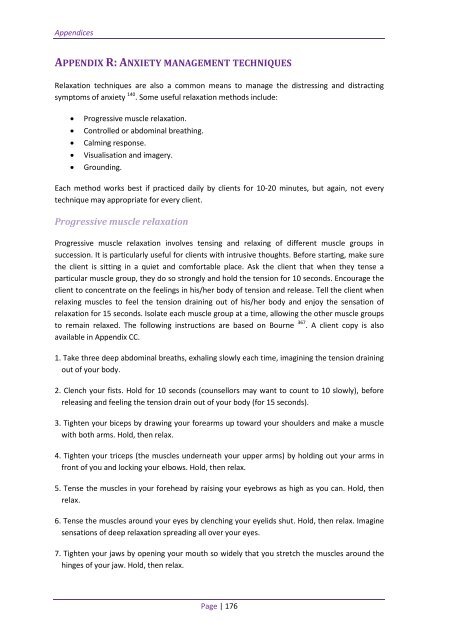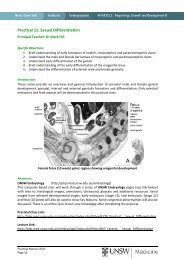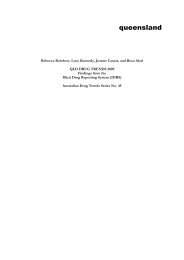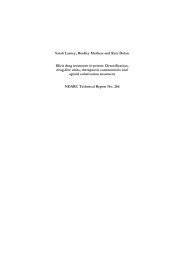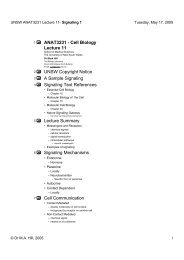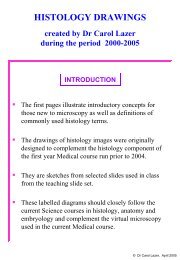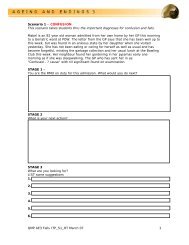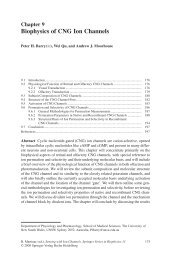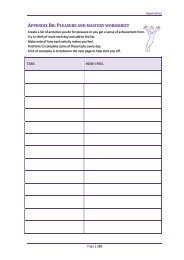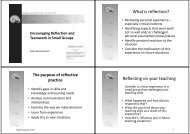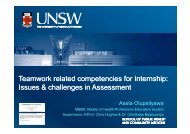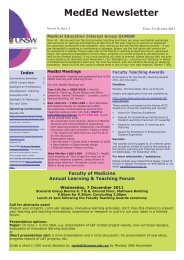APPENDIX R: ANXIETY MANAGEMENT TECHNIQUES Progressive ...
APPENDIX R: ANXIETY MANAGEMENT TECHNIQUES Progressive ...
APPENDIX R: ANXIETY MANAGEMENT TECHNIQUES Progressive ...
Create successful ePaper yourself
Turn your PDF publications into a flip-book with our unique Google optimized e-Paper software.
Appendices<strong>APPENDIX</strong> R: <strong>ANXIETY</strong> <strong>MANAGEMENT</strong> <strong>TECHNIQUES</strong>Relaxation techniques are also a common means to manage the distressing and distractingsymptoms of anxiety 140 . Some useful relaxation methods include:• <strong>Progressive</strong> muscle relaxation.• Controlled or abdominal breathing.• Calming response.• Visualisation and imagery.• Grounding.Each method works best if practiced daily by clients for 10-20 minutes, but again, not everytechnique may appropriate for every client.<strong>Progressive</strong> muscle relaxation<strong>Progressive</strong> muscle relaxation involves tensing and relaxing of different muscle groups insuccession. It is particularly useful for clients with intrusive thoughts. Before starting, make surethe client is sitting in a quiet and comfortable place. Ask the client that when they tense aparticular muscle group, they do so strongly and hold the tension for 10 seconds. Encourage theclient to concentrate on the feelings in his/her body of tension and release. Tell the client whenrelaxing muscles to feel the tension draining out of his/her body and enjoy the sensation ofrelaxation for 15 seconds. Isolate each muscle group at a time, allowing the other muscle groupsto remain relaxed. The following instructions are based on Bourne 367 . A client copy is alsoavailable in Appendix CC.1. Take three deep abdominal breaths, exhaling slowly each time, imagining the tension drainingout of your body.2. Clench your fists. Hold for 10 seconds (counsellors may want to count to 10 slowly), beforereleasing and feeling the tension drain out of your body (for 15 seconds).3. Tighten your biceps by drawing your forearms up toward your shoulders and make a musclewith both arms. Hold, then relax.4. Tighten your triceps (the muscles underneath your upper arms) by holding out your arms infront of you and locking your elbows. Hold, then relax.5. Tense the muscles in your forehead by raising your eyebrows as high as you can. Hold, thenrelax.6. Tense the muscles around your eyes by clenching your eyelids shut. Hold, then relax. Imaginesensations of deep relaxation spreading all over your eyes.7. Tighten your jaws by opening your mouth so widely that you stretch the muscles around thehinges of your jaw. Hold, then relax.Page | 176
Appendices8. Tighten the muscles in the back of your neck by pulling your head way back, as if you weregoing to touch your head to your back. Hold, then relax.9. Take deep breaths and focus on the weight of your head sinking into whatever surface it isresting on.10. Tighten your shoulders as if you are going to touch your ears. Hold, then relax.11. Tighten the muscles in your shoulder blades by pushing your shoulder blades back. Hold thenrelax.12. Tighten the muscles of your chest by taking in a deep breath. Hold, then relax.13. Tighten your stomach muscles by sucking your stomach in. Hold, then relax.14. Tighten your lower back by arching it up (don’t do this if you have back pain). Hold, thenrelax.15. Tighten your buttocks by pulling them together. Hold, then relax.16. Squeeze the muscles in your thighs. Hold, then relax.17. Tighten your calf muscles by pulling your toes towards you. Hold, then relax.18. Tighten your feet by curling them downwards. Hold, then relax.19. Mentally scan your body for any left over tension. If any muscle group remains tense repeatthe exercise for those muscle groups.20. Now imagine a wave of relaxation spreading over your body.Controlled or abdominal breathingWhen tense, a person’s breathing is rapid and shallow, which can lead to hyperventilation orpanic attacks. Hyperventilation is a process where shallow breathing gets rid of too much carbondioxide which can lead to light-headedness, breathlessness, feeling of suffocation, blurred vision,and numbness or tingling in hands or feet as well as a hot, flustered feeling. Mildhyperventilation can lead to increased perpetual anxiety and apprehension.When teaching clients breathing retraining, it is important they understand and feel thedifference between shallow, chest-level breathing and controlled, abdominal breathing. A goodway to do this is to ask clients to practice each type of breathing. However, it is important toinform clients who are extremely anxious that they may experience trouble breathing deeplyand may need to try this when feeling less anxious (some clients may always have trouble withthis). Encourage clients to increase their breathing speed. Ask them to place their hand gently ontheir abdomen and feel how shallow and rapid their breathing is, only the chest moves up anddown. Compare this with abdominal breathing based on the following instructions for the clientprovided by Lee et al. 114 :Page | 177
Appendices1. Rate your level of anxiety on a scale from 1 to 10.2. Sit as comfortably as possible in a chair with your head, back and arms supported, freelegs and close your eyes (if you like).3. Place one hand on your abdomen right beneath your rib cage4. Inhale deeply and slowly, send the air as low and deep into your lungs as possible. If youare breathing from your abdomen you should feel your hand rise, rather than your chest.5. When you have taken a full breath, pause before exhaling. As you exhale imagine all ofthe tension draining out of your body.6. Do 10 slow abdominal breaths. Breathe in slowly counting to four, before exhaling to thecount of four (four seconds in, four seconds out). Repeat this cycle 10 times. Hold finalbreath for 10 seconds, then exhale.7. Now re-rate your level of anxiety and see if it has changed.Controlled breathing techniques can help reduce overall levels of tension and are a usefulstrategy to use when faced with high-anxiety or high-risk situations when relapse is likely. Aclient worksheet for abdominal breathing is included in Appendix DD.Calming responseThis is a quick skill developed by Montgomery and Morris 368 to reduce the discomfort ofunwanted feelings. The basic steps involve the client mentally detaching from the situation andthinking “clear head, calm body” as they take one slow deep breath. As they exhale they relax.Visualisation and imageryThis relaxation technique might be only useful for a select few clients and should not be usedwhere a client finds the process difficult or has unpleasant affects as a result 367 .1. Sit comfortably in a chair, close your eyes and breathe deeply. Clear your mind of allthoughts and images.2. Imagine a place where you feel safe and relaxed; this could be a real or imaginary place.Think in as much detail as possible: What are the sounds? What are the smells? What doyou feel? What do you see?3. Think about how your body feels in this place (e.g., are your muscles relaxed? Is itwarm? Is your breathing and heart rate slow or fast?).4. Stay in this relaxed state for a moment and remember how it feels so you can return toit when you need to.5. Slowly clear your mind again and return to the “here and now” and the sounds aroundyou. Stretch your arms and legs and when you are ready, open your eyes.A client worksheet for visualisation in provided in Appendix EE.Page | 178
AppendicesGroundingFor most clients suffering anxiety symptoms, most breathing and relaxation techniques areeffective; however, for sufferers of panic or trauma some relaxation and breathing strategies canoccasionally trigger flashbacks, intrusive memories, panic, fear and dissociation. AOD workerscan assist these clients and reduce traumatic and panic reactions by focusing the attention ofthese clients on the outside world rather than the internal trauma. This process is known as“grounding” (or distraction, centering, or healthy detachment) 224 .There are different forms of grounding outlined below; different strategies work best fordifferent clients and it is important to use a strategy appropriate to the individual. The examplesof grounding techniques provided below are adapted from Najavits 224 .Examples of mental grounding:• Describe objects in your environment in detail using all your senses.• Describe an every day activity, such as eating or driving to work, in detail.• Use a grounding statement. “I am Jo, I am 23 years old, I am safe here, today is ...”.• Say the alphabet slowly.• Counting backwards from 20.Examples of physical grounding:• Run cool or warm water over your hands.• Press your heels into the floor.• Touch objects around you as you say their names.• Jump up and down.• Change your posture to a more upright one.• Stretch.• As you inhale say “in”, and when you exhale say “out” or “calm” or “easy” or “safe”.Examples of soothing grounding:• Rub nice smelling hand cream slowly into hands and arms and notice the feel and smell.• Say encouraging statements to yourself such as “You’re okay, you’ll get through this”.• Think of favourites of any kind of object (e.g., cars) or animal.• Think of a place where you felt calm and peaceful, describe where you were, what wasaround you and what you were doing.• Plan something nice for yourself such as a bath or a good meal.• Think of things you look forward to doing in the next few days.Page | 179


